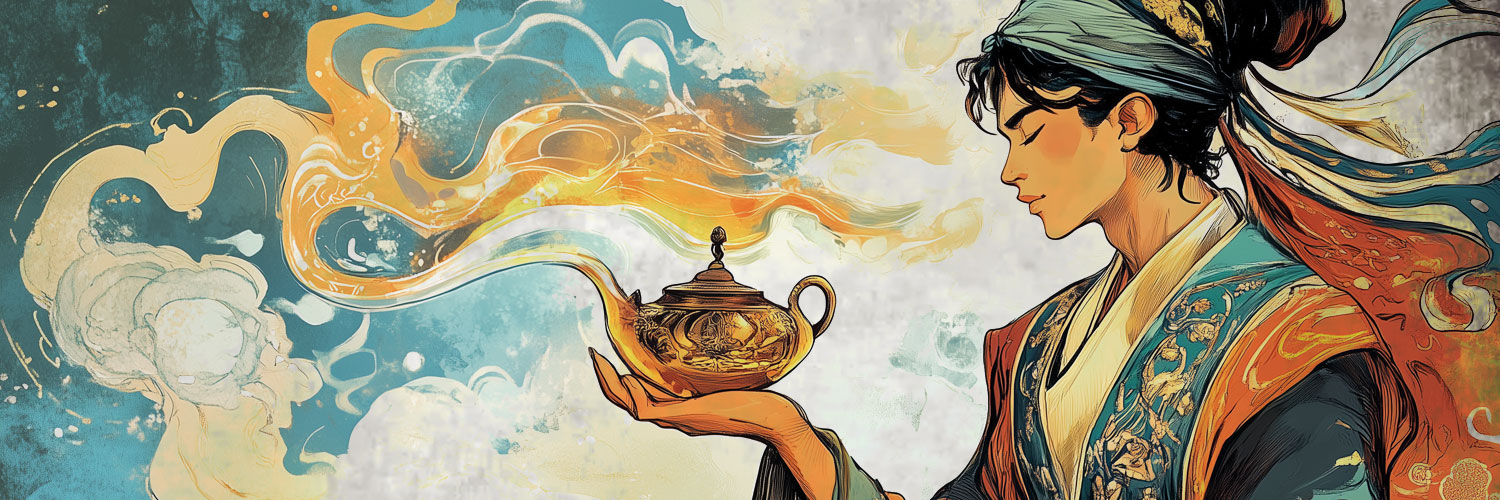

Aladdin, from Aleppo to America
Hanna Diyabb was a translator and story teller, born in Aleppo, Syria in 1688. In the early 1700’s he travelled to Paris, where he met the French writer Antoine Galland, and shared with him some of the ancient tales that together were known as ‘One Thousand And One Nights’, such as ‘Ali Baba And The Forty Thieves’, and ‘Sinbad The Sailor’.
The original Arabic manuscripts for this collection of tales do not include ‘Aladdin’, so it may be that Diyabb created the story, but it was Galland who translated the tales into French, and included Aladdin in an edition of his ‘Arabian Nights’ collection, published in 1717.
In the Diyabb / Galland version, an evil sorcerer from the Maghreb (possibly the Western Sahara), travels to Ancient China to meet a boy named Aladdin, but despite being set in China, the story is a mishmash of Islamic culture and Orientalist fantasy.
In the early 1830’s, Galland’s Aladdin was translated into English, at a time when British Orientalism, an obsession with Eastern Asian culture, design and architecture, was at its height. As a result, the Chinese aspects of the tale were exaggerated, and theatres began staging the story, in the form of pantomimes. The most influential pantomime version was the Theatre Royal Drury Lane’s 1861 Christmas Season. Aladdin’s family, who had been tailors, were switched to running a Chinese laundry, reflecting London life at that time, with Aladdin’s brother being named Wishee Washee, mimicking the broken English of Chinese migrant workers. Aladdin’s mum, Widow Twankey, was named after a cheap brand of Chinese tea.
Aladdin became a hugely popular pantomime, mimicking and mocking Chinese language and culture, with white British performers often using ‘yellow face’ make-up.
In 1992 Disney released their cartoon feature film version of Aladdin, but now the story was set not in China, but in an Arabian fantasy land called Agrabah. A Chinese version was considered by Disney, but rejected, as portraying Chinese culture was deemed to be too risky politically, and the company had ambitions to break into the Chinese market.
It was decided that the Arabian Nights theme was more easily marketable to American audiences, and gave more scope for international audiences, and so Disney presented a stereotyped ‘Middle Eastern’ world, with evil character portrayed with dark skin and strong Arabic features, Aladdin himself being given a light skinned, Tom Cruise look, and most characters being voiced by Western actors.
In recent year’s, UK pantomime productions have presented a slightly confused mix of ‘Oriental’ and ‘Arabian’ styles and settings. Since the theatre industry returned post-pandemic, there have been calls for actors with Middle Eastern ethnicity to be cast in all roles, but this reflects the ‘Disneyfide’ version of Aladdin, and ignores the original East Asian setting.
This year in Sevenoaks we will present a retelling of this ancient tale, which has already been told and retold for Syrian, French, Victorian, American and 21st Century audiences over more than 500 years.
It’s Christmas 2025, and Aladdin and his mother, Dame Elaine Staige, find themselves boarding a plane from Hong Kong for London, after a messy divorce. Carrying the suitcases is Aladdin’s (adopted, but don’t tell him) brother, Silly Billy.
Looking for a brand new life for her family, Dame Elaine arrives in China Town with two kids, a suitcase full of cash, and ambitions to run a Chinese Take Away named after her favourite son.
On the day they open, their very first customer is a Social Media Sensation known as Princess. Aladdin immediately falls in love with her, but he doesn’t have enough followers, or enough cash, to impress her.
Luckily for him, a mysterious stranger, offering riches greater than his wildest dreams, arrives in town. And all Aladdin has to do is help him find an old oil lamp, said to be locked in an antique Chinese cabinet, dumped in the cellar of his very own Chinese Take Away…
Stag Theatre, London Road, Sevenoaks, TN13 1ZZ
Box Office 01732 450175


